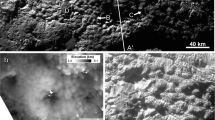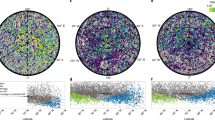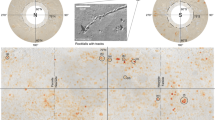Abstract
Hyperion is Saturn’s largest known irregularly shaped satellite and the only moon observed to undergo chaotic rotation1,2,3. Previous work has identified Hyperion’s surface as distinct from other small icy objects4,5 but left the causes unsettled. Here we report high-resolution images that reveal a unique sponge-like appearance at scales of a few kilometres. Mapping shows a high surface density of relatively well-preserved craters two to ten kilometres across. We have also determined Hyperion’s size and mass, and calculated the mean density as 544 ± 50 kg m-3, which indicates a porosity of >40 per cent. The high porosity may enhance preservation of craters by minimizing the amount of ejecta produced or retained6,7, and accordingly may be the crucial factor in crafting this unusual surface.
This is a preview of subscription content, access via your institution
Access options
Subscribe to this journal
Receive 51 print issues and online access
$199.00 per year
only $3.90 per issue
Buy this article
- Purchase on Springer Link
- Instant access to full article PDF
Prices may be subject to local taxes which are calculated during checkout


Similar content being viewed by others
References
Klavetter, J. J. Rotation of Hyperion. I—Observations. Astron. J. 97, 570–579 (1989a)
Klavetter, J. J. Rotation of Hyperion. II—Dynamics. Astron. J. 98, 1855–1874 (1989b)
Black, G. J., Nicholson, P. D. & Thomas, P. C. Hyperion: rotational dynamics. Icarus 117, 149–161 (1995)
Smith, B. A. et al. A new look at the Saturn system: the Voyager 2 images. Science 215, 504–537 (1982)
Thomas, P. C., Black, G. J. & Nicholson, P. D. Hyperion: Rotation, shape, and geology from Voyager images. Icarus 117, 128–148 (1995)
Housen, K. R. & Holsapple, K. A. Impact cratering on porous asteroids. Icarus 163, 102–119 (2003)
Asphaug, E., Ryan, E. V. & Zuber, M. T. in Asteroids III (eds Bottke, W. F., Cellino, A., Paolicchi, P. & Binzel, R. P.) 463–484 (Tucson, Univ. Arizona Press, 2002)
Criddle, K. E. et al. Cassini orbit determination: the only targeted Hyperion flyby of the prime mission. 29th Annual AAS Guidance and Control Conference (Breckenridge, Colorado) AAS Paper∼06–082 (American Astronomical Soceiety, San Diego, California, 2006)
Wisdom, J., Peale, S. J. & Mignard, F. The chaotic rotation of Hyperion. Icarus 58, 137–152 (1984)
Binzel, R. P., Green, J. R. & Opal, C. B. Chaotic rotation of Hyperion? Nature 320, 511 (1986)
Armstrong, J. W., Iess, L., Tortora, P. & Bertotti, B. Stochastic gravitational wave background: upper limits in the 10-6-10-3 Hz band. Astrophys. J. 599, 806–813 (2003)
Clark, R. N., Fanale, F. P. & Gaffey, M. J. in Satellites (eds Burns, J. A. & Mathews, M. S.) 437–491 (Tucson, Univ. Arizona Press, 1986)
Porco, C. C. et al. Physical characteristics and possible accretionary origins for Saturn's small satellites. Annu. Lunar Planet. Sci. Conf. 37, 2289 (2006)
Porco, C. C. et al. Cassini imaging science: initial results on Phoebe and Iapetus. Science 307, 1237–1242 (2005)
Chapman, C. R. et al. Impact history of Eros: craters and boulders. Icarus 155, 104–118 (2002)
Pike, R. J. in Impact and Explosion Cratering (eds Roddy, D. J., Pepin, R. O. & Merrill, R. B.) 484–509 (Pergamon, New York, 1977)
Melosh, H. J. Impact Cratering: A Geologic Process 1–253 (Oxford Monographs on Geology and Geophysics, No. 11, Oxford Univ. Press, New York, 1989)
Richardson, J. E. & Melosh, H. J. Determining comet Tempel 1’s gravity, mass, and density via the ballistic behavior of the Deep Impact ejecta plume. Icarus (submitted).
Sugita, S. et al. Subaru telescope observations of Deep Impact. Science 310, 274–278 (2005)
Carr, M. H. et al. The geology of Gaspra. Icarus 107, 61–71 (1994)
Schenk, P. M. Ganymede and Callisto—Complex crater formation and planetary crusts. J. Geophys. Res. 96, 15635–15664 (1991)
Buratti, B. J., Hicks, M. D. & Davies, A. Spectrophotometry of the small satellites of Saturn and their relationship to Iapetus, Phoebe, and Hyperion. Icarus 175, 490–495 (2005)
Cruikshank, D. P. et al. The dark side of Iapetus. Icarus 53, 90–104 (1983)
Cruikshank, D. P. et al. Surface composition of Hyperion. Nature doi: 10.1038/nature05948 (this issue).
Fanale, F. P. & Salvail, J. R. The water regime of asteroid (1) Ceres. Icarus 82, 97–110 (1989)
Moore, J. M. et al. Mass movement and landform degradation on the icy Galilean satellites: results of the Galileo nominal mission. Icarus 240, 294–312 (1999)
Delsemme, A. H. in Comets (ed. Wilkening, L. L.) 85–130 (Tucson, Univ. Arizona Press, 1982)
Richardson, J. E., Melosh, H. J., Greenberg, R. J. & O'Brien, D. P. The global effects of impact-induced seismic activity on fractured asteroid surface morphology. Icarus 179, 325–349 (2005)
Thomas, P. C. et al. Mathilde: size, shape, and geology. Icarus 140, 17–27 (1999)
Thomas, P. C. Gravity, tides, and topography on small satellites and asteroids—Application to surface features of the Martian satellites. Icarus 105, 326–244 (1993)
Acknowledgements
Technical assistance was provided by B. Carcich, K. Consroe, P. Smith and P. F. Helfenstein. G. Patton checked the crater tabulation on Phoebe and Hyperion. This work was funded in part by the Cassini project. A portion of this work was done at the Jet Propulsion Laboratory, California Institute of Technology, under a contract from NASA. The work of L.I., P.T. and L.S. was funded in part by the Italian Space Agency. The manuscript benefited from reviews by K. Housen and E. Asphaug.
Author information
Authors and Affiliations
Corresponding author
Ethics declarations
Competing interests
Reprints and permissions information is available at www.nature.com/reprints. The authors declare no competing financial interests.
Supplementary information
Supplementary Table S1
This file contains Supplementary Table S1 which summarizes instantaneous spin pole solutions for Hyperion derived from control points measured in Cassini images. (PDF 38 kb)
Rights and permissions
About this article
Cite this article
Thomas, P., Armstrong, J., Asmar, S. et al. Hyperion's sponge-like appearance. Nature 448, 50–53 (2007). https://doi.org/10.1038/nature05779
Received:
Accepted:
Issue Date:
DOI: https://doi.org/10.1038/nature05779
Comments
By submitting a comment you agree to abide by our Terms and Community Guidelines. If you find something abusive or that does not comply with our terms or guidelines please flag it as inappropriate.



